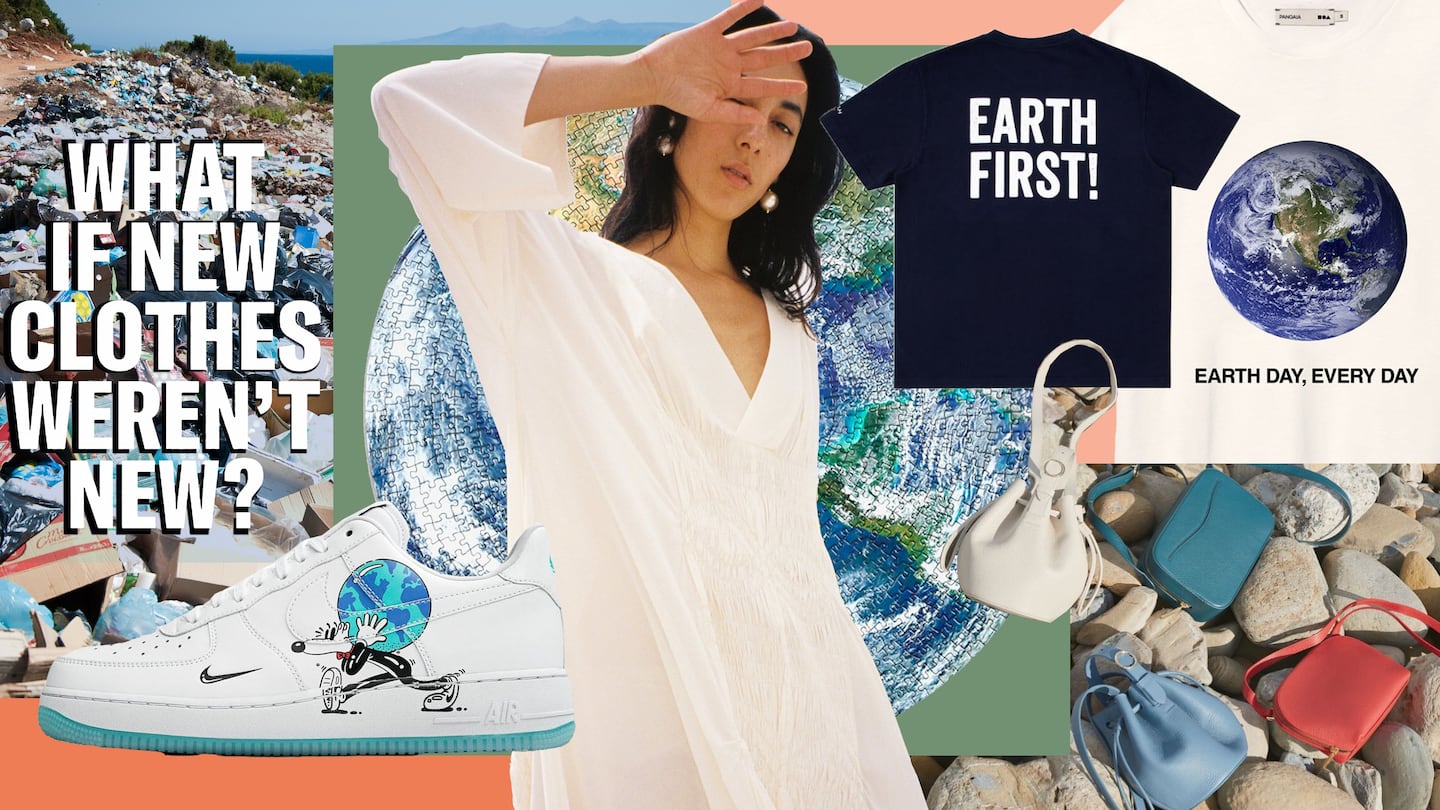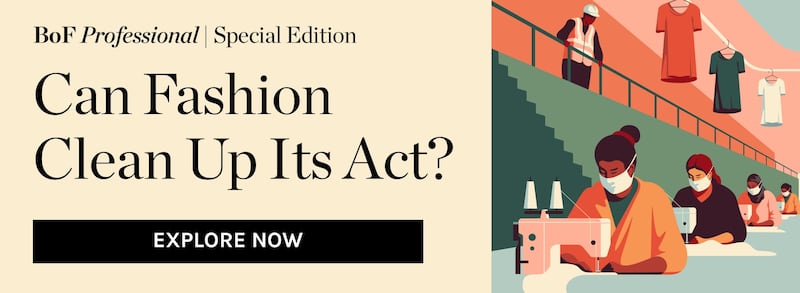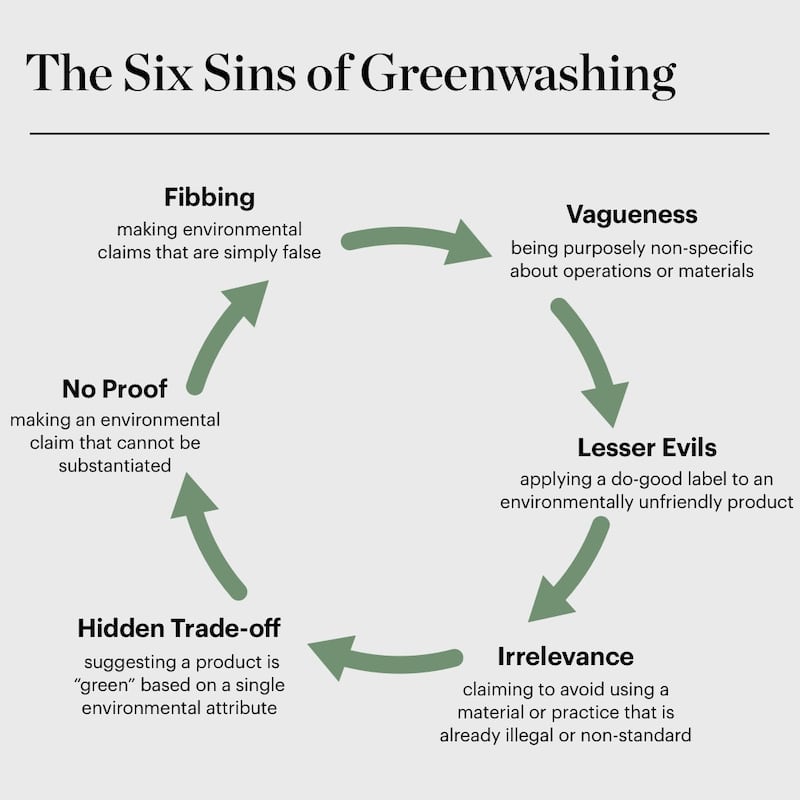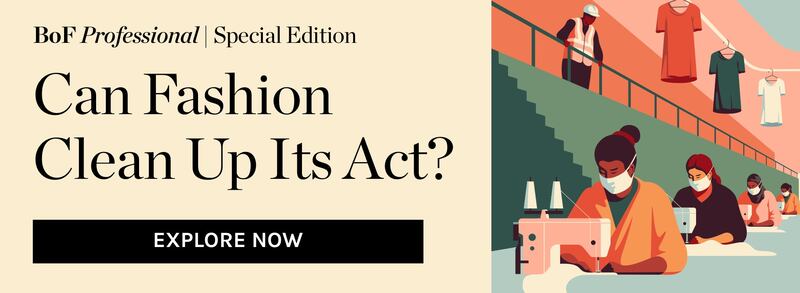
The Business of Fashion
Agenda-setting intelligence, analysis and advice for the global fashion community.

Agenda-setting intelligence, analysis and advice for the global fashion community.


This article is part of BoF's special edition, Can Fashion Clean Up Its Act? Click here to learn more.
NEW YORK, United States — In January, fast fashion behemoth H&M released a merch collection with pop star of the moment Billie Eilish. The capsule collection was "made from materials sourced in a more sustainable way," according to the brand's press release, language that publications ranging from Women's Wear Daily to Refinery29 were quick to repeat in their reporting about the drop.
In addition to its “conscious collections,” H&M, through its parent company's foundation, awards its Global Change prize to innovators in the sustainable fashion space. In April, the Swedish retailer topped Fashion Revolution’s list of most transparent brands for sharing information related to its supply chain and its green and social initiatives.
The public commitments to sustainability, however, failed to resonate with some consumers and advocates who recognise a fundamental discord between fast fashion and sustainability.
ADVERTISEMENT
H&M releases [two] 'conscious collections' a year and calls themselves sustainable... how about you make all your clothes sustainable (and properly disclose how they're even sustainable). How about you pay your workers liveable wages and give them good working conditions.
One Twitter user wrote, "H&M releases [two] 'conscious collections' a year and calls themselves sustainable... how about you make all your clothes sustainable (and properly disclose how they're even sustainable). How about you pay your workers liveable wages and give them good working conditions." Another user asked, "in order to be labelled 'conscious,' H&M requires products be made of at least 50 [percent] sustainable materials. Are you claiming that all of this merch exceeds that standard, even though only two items are labelled as conscious online? What about this 100 [percent] acrylic hat?"
“From our perspective, neither H&M nor its ‘conscious collections’ cuts it,” said Ayesha Barenblat, founder and CEO of nonprofit Remake. “[H&M] puts out a lot of volume of product, which is built for rapid obsolescence, which has a terrible impact on climate justice and on women. So, there's just no way with some percentage of recycled materials to become a ‘conscious collection,’ given...how tiny the capsule collection is compared to the core business.”
The disjoint illustrates how easily consumers today sniff out the shortcomings between what brands are able to deliver — in terms of their communications but more importantly, in their environmental and social operations and standards — and the reality of the business.
To be sure, it's not only H&M that has fallen into the greenwashing trap. In April, direct-to-consumer brand Everlane garnered headlines over allegations of union-busting practices, which resulted in more than 40 layoffs at the company. The coronavirus also exposed a garment worker crisis in Bangladesh, in which Western brands — Gap and Primark among them — initially failed to pay suppliers and cancelled orders as the global fashion supply chain came to a halt (on this front, brands including H&M and Nike made public commitments to honour existing purchase orders).
“When you build your reputation on being radically transparent, your customer base really trusts you,” said Barenblat. “But when you shatter that trust, it’s amazing how quickly the pitchforks come.”
What is Greenwashing?
Greenwashing — when a brand’s marketing around sustainability runs counter to its business practices — is rampant in fashion. Buzzwords like “eco-friendly” and “conscious” litter marketing messages and advertisements while offering no practical meaning to consumers. The fashion industry’s attempt to gloss over its biggest problem has made it such that brands whose essence is rooted in sustainability are starting to reject the term altogether. As Carrie Ellen Phillips, whose communications and brand consultancy firm BPCM launched its sustainability division in 2019 to advise clients how to incorporate sustainability into their messaging but also their operations, put it, “I hate the word ‘sustainability.’”
To be fair, there isn’t a universally agreed-upon definition of sustainability, leaving room for brands to either fall into the greenwashing trap or exploit the vagueness surrounding it. It also allows brands to tout red herrings as progress while concealing problem areas.
ADVERTISEMENT
But without a truly comprehensive approach to impact that includes environmental, labour and social change, the marketing itself rings hollow.
“A lot of brands will trump the environmental claims, but will be very slim when it comes to their social and labour side of things, and we really look at the two things as hand-in-hand,” said Barenblat. “To be a truly sustainable brand, you have to think about people and the planet.”
There are many ways that brands fall prey to greenwashing, however well-intentioned they may be. In some of the more insidious cases, brands might attempt to beguile consumers with misleading or unverifiable claims, if not altogether obfuscating their supply chain practices. But without a truly comprehensive approach to impact that includes environmental, labour and social change, the marketing itself rings hollow.
While brands face a litany of compromises on the path towards sustainability, it's how they deal with them that determines how consumers and activists will judge them in kind.

Source: TerraChoice
Greenwashing in fashion isn’t a new phenomenon, although it spreads more quickly by virtue of the internet and its many social media platforms.
In 2007, the group TerraChoice published the Six Sins of Greenwashing, most of which are still applicable today: The Sin of Vagueness, in which a brand is purposely non-specific about its operations or materials; The Sin of Lesser Evils, in which a do-good label is slapped onto an inherently environmentally-unfriendly product (like, “sustainable denim,” where denim is among the most resource-intensive garments to produce); or The Sin of Irrelevance, where a company may claim to avoid using a material or practice that is already illegal or non-standard.
A Fashion Reset
Insiders have long called for a reset in fashion, but the coronavirus pandemic accelerated the conversation around some aspects of sustainability.
ADVERTISEMENT
According to McKinsey & Company, 70 percent of fashion stakeholders see closer partnerships with suppliers increasing, and more than 60 percent believe that sustainable materials will become mainstream. Meanwhile, for consumers, the feelings around eco-friendly purchases have intensified in tandem. In a late April survey, Forrester Research found that 41 percent of US online adults said they would prefer to buy products that are environmentally friendly after the pandemic.
At the crux of the greenwashing trap is a question of credibility: is the data the brand is publishing factual? How can consumers verify claims? The consequences of greenwashing run deeper than misleading consumers. Not only does it dilute the value of any genuine progress that a brand might be making elsewhere, it also dilutes the accomplishments of real impact-focused brands, thereby creating doubt over claims that any company is doing good.
Protecting factory workers and working with ethical suppliers is as important, if not more important, as the amount of water used to produce a pair of jeans.
"When [brands] claim that 'we are the most sustainable,' or 'the most responsible' or 'we are the most transparent,' those need to be looked into with scrutiny because when brands are self-congratulating themselves in that fashion, that means that they probably have spent a lot of money on the message but very little money on actual certification," said Céline Semaan, founder of Slow Factory Foundation, a fashion and social impact nonprofit.
Another coil in the greenwashing trap is the idea that brands only address their materials or packaging, neglecting the human element central to any question of whether a brand is sustainable. Protecting factory workers and working with ethical suppliers is as important, if not more important, as the amount of water used to produce a pair of jeans.
“The opportunity in this moment is to ensure that brands are not purpose-washing, not just looking at where their product or service intersects with a culture or with the conversation of the moment, but to really look internally inside of their businesses to understand how their operations or their practices are impacting their stakeholders,” said B Lab co-CEO for the US & Canada Anthea Kelsick.
Gone are the days where spin reigns supreme: an honest business begets honest marketing. Read on as we break down how to avoid the greenwashing trap (spoiler: long-term commitments required).
1. Before the email blasts are sent out, look within
For brands that want to get in front of any greenwashing accusations, begin by looking within. A firm’s mindset over “sustainability” must go beyond external actions or consumer-facing products and services. What does your own team look like internally? Are you treating your own employees fairly? Where does your supply chain become problematic? (Hint: You’ll have to look beyond your tier one suppliers.)
“Where you see a lot of mistakes happen is when sustainability is an afterthought,” said Erica Cerulo, one-part of the duo brand consultancy Claire and Erica. “It becomes this sort of marketing or social media initiative, not a business initiative.”
First, there needs to be either an individual or a team tasked with taking a look at a brand's impact. Vestiaire Collective, the designer resale platform, recently hired its first Chief Sustainability Officer, while luxury giant Kering has had their sustainability chief in place since 2012. Eileen Fisher, the longtime sustainable contemporary brand, has a dedicated supply chain transparency specialist on its team.
Kelsick, whose company is best known for the third-party certification it offers for businesses that meet its social and environmental impact standards, said fashion brands need to improve most when it comes to issues around their supply chain and workers.
2. Work with the right strategic partners and stakeholder groups
To build credibility in the sustainability space, brands must also identify the right strategic partners and stakeholders, whether they are suppliers, complementary businesses or advocacy groups. For example, Vestiaire Collective partnered with eco-minded The Laundress, Restory, and The Steamery, companies that each focus on extending a garment’s lifetime.
Among the nonprofit sustainability partners focused on the fashion industry are The New Standard Institute and the Ellen MacArthur Foundation, though there are countless others with which brands can work, or at the very least, refer to for educational resources. For its part, The New Standard Institute is launching an open-source information platform this summer that will host reputable data that brands can use to educate themselves, rather than relying on Google searches, said founder Maxine Bédat. Meanwhile, fashion sustainability nonprofit Remake has its free Sustainability Criteria tool for brands to evaluate their operations.
New York-based Mara Hoffman, for example, lists 12 nonprofit and sustainability groups with which the brand partners on its impact initiatives on its website. But it's important that brands that seek nonprofit partnerships do so earnestly, rather than simply ticking boxes off a list. Ethical Fashion Initiative — which works to connect marginalised artisans with fashion brands and suppliers like Brother Vellies and luxury textile manufacturer Ratti — does not work with brands on merely a collection or two, said founder Simone Cipriani.
Another tool in impact marketing is donation-based partnerships with a nonprofit. Brands considering this approach should think first about whether they are simply trying to buy a seal of approval, a common criticism against this kind of initiative, not to mention whether the brand's values are at odds with the nonprofit itself, a subject Semaan's Slow Factory Foundation outlines in its Impact Marketing Guide.
3. Create an impact report supported by verifiable information and data
One of the most valuable assets a brand can have when it comes to making the case that it’s moving towards real sustainability is an impact report. Some brands like Nike publish theirs annually, while others like Reformation publish theirs quarterly. Impact reports should include both information about a brand’s environmental footprint, as well as its commitments to social responsibility, though reports shouldn’t necessarily be rigid in their structure.
Still, Bédat said that while plenty of brands publish impact reports, few, if any, include the kind of data that actually matter, including information related to greenhouse gas emissions and wage levels relative to the standard living wage in the workers’ country.
“Because there is no standard in the fashion industry on what those reports are supposed to include, brands just cherry-pick [data],” Bédat said. It’s not enough.
And while brands can share impact reports with consumers, the question then becomes: Who’s fact-checking the claims? Here, third-party certifications become valuable to brands eager to avoid the greenwashing trap.
Eco-Age, a sustainability consultancy, has a system for evaluating brands on the basis of 12 different areas related to impact, which culminates in brand sustainability “report cards.” B Corp offers a free impact assessment to brands interested in earning B Corp certification. The Sustainable Apparel Coalition has its proprietary Higg Index to measure a company’s sustainability performance.
Third-party certifications offer an objective benchmark by which consumers can evaluate and compare brands while reducing the likelihood of greenwashing, said Katherine White, the academic director of the Dhillon Centre for Business Ethics at the University of British Columbia’s Sauder School of Business.
4. Go the distance with plain old honesty
In early 2018, the menswear brand Noah published a blog about sustainability to its brand website, though it wasn’t at all the kind of self-congratulatory message consumers are used to hearing from brands.
“We need to set the record straight: Noah is not a sustainable company,” the brand published to its blog. “Although we're very flattered that the press and our supporters frequently complement our engagement on environmental issues, the way we operate isn't even close to sustainable. There's really no such thing as a sustainable clothing company.” From a marketing perspective, the counter-programming was genius, but simple: While consumers are used to environmental activists preaching about the problems in fashion, rarely does a fashion brand itself position itself at the centre of the problem.
The injection of humility serves as an example to other brands. “In this new world of sustainability and transparency, the most important thing is humility,” said BPCM’s Phillips. “It is okay to say, ‘with all of the information that is now available to us, we now want to make better decisions, because it is clear that we can. Here are the first steps we are taking. Please join us on this journey and if you can, if you can do that.’”
There are other instances in which a brand's radical transparency around the nuances of sustainability can foster goodwill with consumers. Cuyana, the leather goods brand whose slogan is "fewer, better things," told BoF that their struggle comes not from reconfiguring their supply chain, a common entanglement for brands retroactively fitting sustainability into their business model, but in communicating the kind of tradeoffs that regularly challenge their fundamental values. Is it better to use 100 percent organic cotton, a biodegradable fabric "that's easier to market," but isn't as durable as a garment that uses some plastic, all the while requiring a third of the water to produce? Shilpa Shah, Cuyana co-founder wondered.
“A lot of times, what people do is they don't actually talk about the nuances or the trade-offs — because there are some times where we have to make a trade-off more for longevity which we feel will have a longer sustainable impact,” said Shah. “People currently just treat this as very black and white, and we try to say that there are shades of grey in between.”
In this way, it’s important to level with consumers and other stakeholders about the compromises brands often have to make between material use and customer satisfaction. Being honest about using plastic or some other non-biodegradable material is preferable to misrepresenting a garments’ materials, even if it means admitting the brand isn’t perfect.
Conversely, peacocking around sustainability is among the biggest tip-offs to greenwashing. Superlatives around being the best or doing the most — as well as promoting a big campaign around Earth Day — are an alert for watchdogs and consumers alike, said Erin Allweiss, co-founder of communications firm No. 29, which represents brands whose businesses are impact-focused.
5. Be clear about commitments
Another surefire way to attract criticism over a brand’s marketing is to republish false or unverified information (like the oft-cited claim that fashion is the second-most polluting industry). Phillips advises brands to “go to the source,” citing scientists, white papers, and government data as the best way to avoid encountering dubious information.
Equally important is the language used to describe a brand’s initiatives. Words like “eco-friendly” are convenient, but ultimately have no legal meaning or grounding for consumers to understand them.
“The usual go-to buzzwords have zero impact at best. In fact, they can even have a negative impact,” said Alex Protopapas, chief content officer at Persado, an AI marketing platform. “Saying nothing at all is often — and with statistical significance — more effective, in terms of inspiring effective customer experiences that lead to actual purchases, than saying what everyone else is saying.”
Protopapas said there should be an education component to every marketing message around sustainability. “‘Here’s how this was made’ or 'This is why we’re changing our production values'…[these are] examples of ways you can introduce actual meaningful information and, by doing so, show you’re a brand that cares as opposed to a brand that’s trying to check off the ‘woke’ box."
Allweiss has noticed that some of her clients are leaning into more scientific language like "biodynamic" with demonstrative definitions to explain their practices. In 2019, "carbon neutral" became a popular designation for everything from Gabriela Hearst's fashion show to individual products, though that identifier is contentious. The more complicated the term used in a marketing message, the deeper the explanation should be to consumers about what it means in relation to a specific brand. (Allweiss acknowledged the difficulty in balancing traditional marketing with substantive language, noting that a brand's advertisement, limited in its details simply by its format, might point consumers towards a brand's website where more detailed information is available.)
As it turns out, marketing professionals feel much the same about the word “authentic” as they do “sustainable,” namely that its meaning has been so diluted that it has become something of a nothingburger. Still, the best thing a brand can do is represent itself in the sustainability conversation as much in line with its brand codes as possible.
For example, when Econyl — a proprietary fabric that the Italian firm Aquaphil manufactures from throwaway fishing nets and other waste — became the material-du-jour for fashion brands looking for a leg up on the environmental impact front, it found itself used frequently in swimwear (every brand using it eager to espouse their contribution towards saving the ocean.) But arguably Prada’s approach felt more authentic when it reissued its brand-defining Nylon bags in 2019, using Econyl to lean into the latest in materials innovation while paying homage to its brand’s heritage.
Ultimately, the worst thing a brand can do is underestimate its consumer, either with fuzzy language or flat-out deception around its business.

BoF Professional Special Edition: Can Fashion Clean Up Its Act?
As the world grapples with an unprecedented public health and economic crisis, exposing deep-rooted social inequality as a climate emergency looms, the fashion industry must learn to respect both people and the planet. It's time for fashion to build a more responsible business model. Explore the full special edition here.
1. Can Fashion Clean Up Its Act?
2. Will Fashion Ever Be Good for the World? Its Future May Depend on It
3. How to Avoid the Greenwashing Trap
4. Luxury Brands Have a 'Respect Deficit' with Indian Artisans
5. Investing in the Sustainability Sisterhood
6. Why Luxury Came to the Rescue
7. The BoF Podcast | Jochen Zeitz on the Power of Fashion to Drive Sustainable Change
and more.
The BoF Professional Summit: How To Build a Responsible Fashion Business
On June 17 2020, we will gather leading global experts, entrepreneurs and activists in sustainability, ethical supply chains and workers' rights for a half-day programme of interactive conversations, panel discussions and workshops on building a responsible business, led by BoF's expert editors and correspondents. Space is limited. Register now to reserve your spot.
Practitioners of this historically behind-the-scenes profession are building powerful followings, riding a wave of interest in how the fashion sausage is made. But even the highest-profile PRs caution that the client still has to comes first.
Join us for a BoF Professional Masterclass that explores the topic in our latest Case Study, “How to Create Cultural Moments on Any Budget.”
When done effectively, a cultural partnership can rightfully earn its own place in the zeitgeist. But it’s not so easy as just hiring a celebrity to star in an ad campaign; brands must choose a partner that makes sense, find the format that fits best and amplify that message to consumers.
Calvin Klein’s chief marketing officer Jonathan Bottomley speaks to Imran Amed about the strategy behind the brand’s buzzy Jeremy Allen White-fronted campaign.